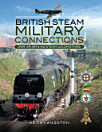British Steam: BR Standard Locomotives
nov. 2012 · Casemate Publishers
Carte electronică
208
Pagini
family_home
Eligibilă
info
reportEvaluările și recenziile nu sunt verificate Află mai multe
Despre această carte electronică
A history of post second world war steam locomotive design and construction in Great Britain, the perfect gift for railroad history buffs.
After WWII the existing railway companies were all put into the control of the newly formed British Transport Commission and that government organization spawned British Railways, which came into being on January 1st 1948. The railway infrastructure had suffered badly during the war years and most of the steam locomotives were “tired” and badly maintained and or life expired. Although the management of British Railways was already planning to replace steam power with diesel and electric engines, they still decided to build more steam locomotives as a stop gap. Some 999 Standard locomotives were built in twelve classes ranging from super powerful express and freight engines to suburban tank locomotives. The locomotives were mainly in good order when the directive came in 1968 to end steam, some trains were only eight years old. There still exists a fleet of forty-six preserved Standards of which 75% are in working order in and around the UKs preserved railways, furthermore three new build standard locomotives are proposed. Steam fans who were around in the 1960s all remember the “Standards.”
After WWII the existing railway companies were all put into the control of the newly formed British Transport Commission and that government organization spawned British Railways, which came into being on January 1st 1948. The railway infrastructure had suffered badly during the war years and most of the steam locomotives were “tired” and badly maintained and or life expired. Although the management of British Railways was already planning to replace steam power with diesel and electric engines, they still decided to build more steam locomotives as a stop gap. Some 999 Standard locomotives were built in twelve classes ranging from super powerful express and freight engines to suburban tank locomotives. The locomotives were mainly in good order when the directive came in 1968 to end steam, some trains were only eight years old. There still exists a fleet of forty-six preserved Standards of which 75% are in working order in and around the UKs preserved railways, furthermore three new build standard locomotives are proposed. Steam fans who were around in the 1960s all remember the “Standards.”
Despre autor
Fred Kerr was born in Edinburgh in 1948 where he gained an interest in railway locomotives from both the LMSR and LNER companies whose services permeated the local network. When his parents moved to Corby in 1956 the local steelworks provided further interest from its mix of freight services, including seeing the last of the Beyer Garrets and the replacement Standard Class 9Fs whilst the industrial locomotives of the internal steelworks network offered further insight into the variety of steam locomotives. This was a time of change and during the 1960s the interest in locomotives included the new order of diesel and electric traction without reducing the interest in steam traction. Whilst his interest in Diesel Traction led to his early involvement with the Diesel & Electric Group and its preservation activities during the 1970s, his move to Southport in 1982 restored his opportunities to return to his first love of viewing steam locomotives at work and this album records some of the locations that he chose to visit and the locomotives that he was able to photograph.
Today his interest continues as a life member of the A4 Locomotive Society, Keighley & Worth Valley Railway and Ribble Steam Railway whilst he also support bodies concerned with preserving steam locomotives, diesel locomotives and infrastructure extensions.
Today his interest continues as a life member of the A4 Locomotive Society, Keighley & Worth Valley Railway and Ribble Steam Railway whilst he also support bodies concerned with preserving steam locomotives, diesel locomotives and infrastructure extensions.
Evaluează cartea electronică
Spune-ne ce crezi.
Informații despre lectură
Smartphone-uri și tablete
Instalează aplicația Cărți Google Play pentru Android și iPad/iPhone. Se sincronizează automat cu contul tău și poți să citești online sau offline de oriunde te afli.
Laptopuri și computere
Poți să asculți cărțile audio achiziționate pe Google Play folosind browserul web al computerului.
Dispozitive eReader și alte dispozitive
Ca să citești pe dispozitive pentru citit cărți electronice, cum ar fi eReaderul Kobo, trebuie să descarci un fișier și să îl transferi pe dispozitiv. Urmează instrucțiunile detaliate din Centrul de ajutor pentru a transfera fișiere pe dispozitivele eReader compatibile.







